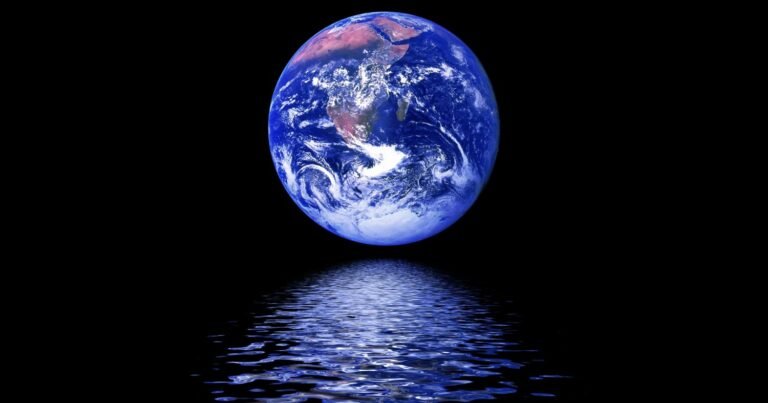The most consequential choice that our technological civilization can make is between commercial benefits and preserving nature. I made my choice long ago following my upbringing on a farm. I love nature the way it is. Despite what mathematical physicists believe, truth is not always beautiful, and we better not cover the pimples of natural reality with artificial makeup.
Every morning at sunrise, I jog in the company of birds, rabbits, ducks, and wild turkeys, and sometimes spectacular snow – as I witnessed today. To keep my mind focused on the natural world, I have no personal account on social media. As a scientist, I wish to learn from evidence about nature and not from processed opinions. Put simply, my guiding principle is “from farm to (intellectual) table”.
Unfortunately, not everyone subscribes to my club. This is evident from the apparent scars that commercial enterprises imprinted on nature. The Earth in the 21st Century is not displaying the same natural beauty as it used to. Let me illustrate my frustration with two examples. One involves looking up to the sky, and the other involves looking down into our oceans.
As an astronomer, I cherish the dark sky without pollution from city lights. On a new Moon, the stars of the Milky Way galaxy resemble lights in the cabins of a giant ship sailing through the dark ocean of cosmic space. I often wonder whether other sentient passengers occupy some of these cabins and look at our sunlight with similar awe.
Astronomers build telescopes in remote and elevated locations to avoid light pollution. But commercial interests lead companies like SpaceX to fill the night sky with thousands of artificial lights. These take the form of internet satellites that reflect sunlight from their surface at their high elevation, similar to the Moon. There are now more than 3,580 Starlink satellites orbiting Earth, and the number could rise to 12,000 in the coming years, with a potential extension to 42,000.
The bright streaks of satellites in telescope images would contaminate large-scale surveys of the sky. For example, the forthcoming Legacy Survey of Space and Time (LSST), with the 3.2-billion-pixel camera of the Vera C. Rubin Observatory in Chile, intends to scan the entire Southern sky every four days starting next year. I am particularly concerned that the ability of the survey to identify unusual interstellar objects, like `Oumuamua, will be compromised by the bright satellite streaks in our sky.
Most recently, a giant new communications satellite that outshines most stars in the night sky started to interfere with astronomical observations. BlueWalker 3 is a prototype antenna that was designed and built by the company AST SpaceMobile. Its mirror-like dish has a surface area of approximately 64 square meters, making it the biggest commercial communications array ever launched into orbit. The company plans to launch a fleet of more than 100 similar or even larger satellites in the future, as a worldwide mobile network.
The damage that humans inflict on nature can also be seen by looking into our oceans. At least 14 million tons of plastic end up in the ocean every year. Plastic makes up 80% of all marine debris found from surface waters to deep-sea sediments. Studies estimate there are now up to 51 trillion pieces of plastic in the world’s oceans, more than the number of galaxies in the observable volume of the universe. At current rates, plastic is expected to outweigh all the fish in the sea by 2050.
In a couple of months, I will be leading an expedition to retrieve fragments from the first interstellar meteor in the Pacific Ocean. At a Zoom meeting yesterday with the expedition team, I asked whether plastic would interfere with our scientific mission since our magnetic sled is likely to trap plastic in addition to any meteoritic spherules.
Marine species ingest plastic debris, which causes injuries and death. Chemicals associated with plastic materials are carcinogenic and may cause developmental, reproductive, neurological, and immune disorders in both humans and wildlife that consume seafood. As argued by the visionary ocean advocate, skipper, and artist, Emily Penn: “The problem starts on our doorsteps. It’s only natural that the solutions can, too.”
Looking up towards our sky or down into our oceans returns the same message. We must look inwards and change our priorities. The Universe teaches us modesty as long as we can see it through the cloud of our commercial enterprises. If we do not change course soon enough, our home planet will be so polluted that in order to see nature, we will have to leave Earth.
Jogging at sunrise on the frozen desert of Mars is not appealing to me. I might have given it a try a few billion years ago when Mars had an atmosphere and oceans on its surface. But not now.
And traveling out of the Solar system with our existing spacecraft would take tens of thousands of years to the nearest planetary system around Proxima Centauri and half a billion years on a journey to a habitable exoplanet on the other side of the Milky Way.
Out of cosmic modesty, we must do a better job at keeping our sky and oceans clean. This will be a modest sign of gratitude to the one planet that gave birth to our technological civilization. The naturalist and philosopher Henry Thoreau, who lived near my home, wrote in his book Walden, “I went to the woods because I wished to live deliberately, to front only the essential facts of life, and see if I could not learn what it had to teach, and not, when I came to die, discover that I had not lived.”
Here’s hoping for a future where the only city lights we see in our night sky will be on the night side of exoplanets and the only technological debris we find in our oceans will be from an extraterrestrial craft that appeared as interstellar meteors in our atmosphere.
Avi Loeb is the head of the Galileo Project, founding director of Harvard University’s – Black Hole Initiative, director of the Institute for Theory and Computation at the Harvard-Smithsonian Center for Astrophysics, and the former chair of the astronomy department at Harvard University (2011-2020). He chairs the advisory board for the Breakthrough Starshot project, and is a former member of the President’s Council of Advisors onScience and Technology and a former chair of the Board on Physics and Astronomy of the National Academies. He is the bestselling author of “Extraterrestrial: The First Sign of Intelligent Life Beyond Earth” and a co-author of the textbook “Life in the Cosmos”, both published in 2021. His new book, titled “Interstellar”, is scheduled for publication in August 2023.

